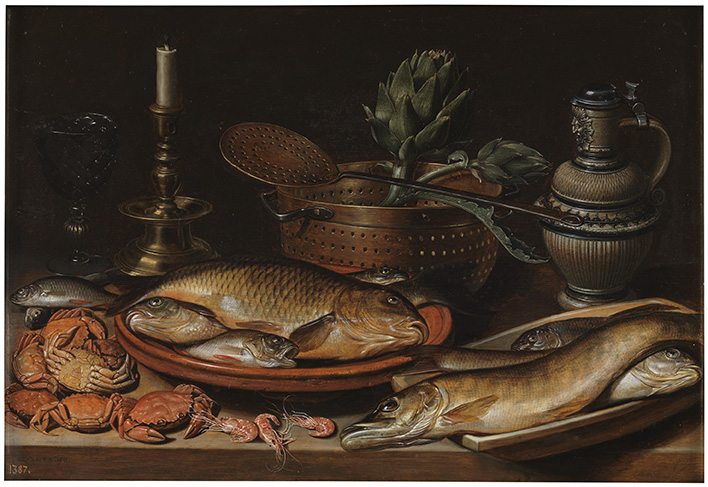Flemish banquets at the Prado
Clara Peeters was among the first and most accomplished painters to specialize in food-laden still lifes, replete with cheese and delicate biscuits, candy, and nuts as well as ornate vessels and floral bouquets. Revered especially for her playful use of light and reflection—for example her own distorted portrait shown on the polished surface of a gilded covered cup—the artist nevertheless remains a mysterious figure. Little is known about her other than that she is presumed to have been born in Antwerp and worked between about 1607 and 1621, enjoying, exceptionally for a woman of her era, high professional repute within her lifetime.

Still life with Flowers, Gilt Goblet, Almonds, Dried Fruits, Sweets, Biscuits, Wine and a Pewter Flagon by Clara Peeters, 1611. Museo Nacional del Prado, Madrid.
The Prado now brings together twelve of the roughly thirty-five canvases that scholars agree can be attributed to Peeters for the second iteration of an exhibition shown at Antwerp’s Museum voor Schone Kunsten this past summer. Significantly, this is the first exhibition that the Prado has ever devoted to a female painter.
Featuring the four works owned by the museum, as well as loans from Antwerp and beyond, the exhibition offers the rare chance to contemplate the artist’s entire body of work. Decorative arts enthusiasts will find much to study in glassware, silver, cutlery, and other objects meticulously depicted by Peeters. Food historians can, through these canvases, learn about early forms of cheeses and other elegant nibbles. Art historians can consider her innovative and evocative compositions and complex intertwining of realism and symbolic content.

Still life with Fish, Candle, Artichokes, Crabs and Shrimp, by Peeters, 1611. Museo Nacional del Prado
Above and beyond their scholarly interest, Peeters’s paintings are notable for their sheer visual delight. An English-language catalogue accompanies the show.
The Art of Clara Peeters • Museo Nacional del Prado, Madrid • to February 19, 2017 • museodelprado.es
Orphan feasts beyond the Dickensian workhouse
London’s Foundling Hospital, established in 1739, was the U. K.’s first children’s charity (it continues to operate today as the foundation Coram) and, with the patronage of William Hogarth, its first public art gallery. A new temporary exhibition at the Foundling Museum, created in one of the hospital’s original buildings, looks closely at the first two centuries of the dining habits of its wards. It examines the four basic food groups (bread, milk, meat, and a surprisingly large amount of vegetables cultivated in the hospital’s own gardens) as well as the implements used to consume them. This, however, serves merely as a jumping-off point from which to consider the underlying philosophies that informed both theory and practice. Guest curator Jane Levi explains, “Far from the miserable gruel of the stereotypical workhouse, the foundling children ate three balanced meals a day . . . off Spode china.”

The boys’ dining room at the Hertfordshire Foundling Hospital, Berkhamsted. © The Foundling Museum.
Fine porcelain, cutlery, and an unexpected amount of veg might distinguish the foundlings from the Dickensian children of the workhouse. But while the Foundling’s governors advocated an enlightened approach and an overall generosity of spirit (as contrasted to comparable institutions of the era), theory and practice often diverged, as this show reveals in its marriage of inventories and objects. Children were made to eat in silence and often in front of spectators; the best food rarely made it to their mouths, having been sold off on the black market. As it assesses accounts of truth versus fiction, this exhibition about meals at a model charity invites us to rethink how to steer charitable donations in a meaningful way.
Feeding the 400 • Foundling Museum, London • to January 8, 2017 • foundlingmuseum.org.uk
A bourgeois cabinet of curiosities in Aachen
Expanding upon the always fascinating theme of the cabinet of curiosities, a new installation at Aachen’s Suermondt-Ludwig-Museum evokes the Kunstkammers of bourgeois industrialists of the nineteenth century, drawing particularly on works owned by those whose donations form the backbone of the institution’s holdings. Objects on view range from an extravagantly carved Slovakian table centerpiece, engraved crystal cups, carved ivory sculptures, fanciful silver goblets, and ancient Greek vases to fossils, coral, and minerals. An enormous taxidermied crocodile suspended from the ceiling floats above it all. Curator Michael Rief’s thought-provoking pre sent a tion reveals the reasons collectors brought such things together. Using the SuermondtLudwig’s limited budget, for this installation he has augmented the museum’s assets with items such as a pair of “pornographic dice,” carved from bone in Germany in the seventeenth century, that resembles a crouching couple. In doing so he expands our understanding of the Kunstkammer tradition from Renaissance rulers to the princes of the Industrial Revolution and demonstrates that this remains a viable arena for contemporary collectors.

Die in the shape of a female nude, German, 17th century. Courtesy Suermondt-Ludwig- Museum.
Wonders and Amazements: The Bourgeois Kunstkammer • Suermondt-Ludwig-Museum, Aachen, Germany • opens December 7 • suermondt-ludwig-museum.de
Winter Olympia
The Winter Art & Antiques Fair Olympia holds its twenty-sixth edition from October 31 to November 6 at the Olympia exposition center in Hammersmith, London. Less famous than its summer cousin, it remains a perennial favorite (approximately twenty thousand people attended last year). With more than 120 dealers exhibiting art and objects from prehistory onward, it retains a holiday air for sophisticated shoppers and knowledgeable decorators.
Winter Art & Antiques Fair • Olympia, London • October 31– November 6 • olympia-antiques.com

